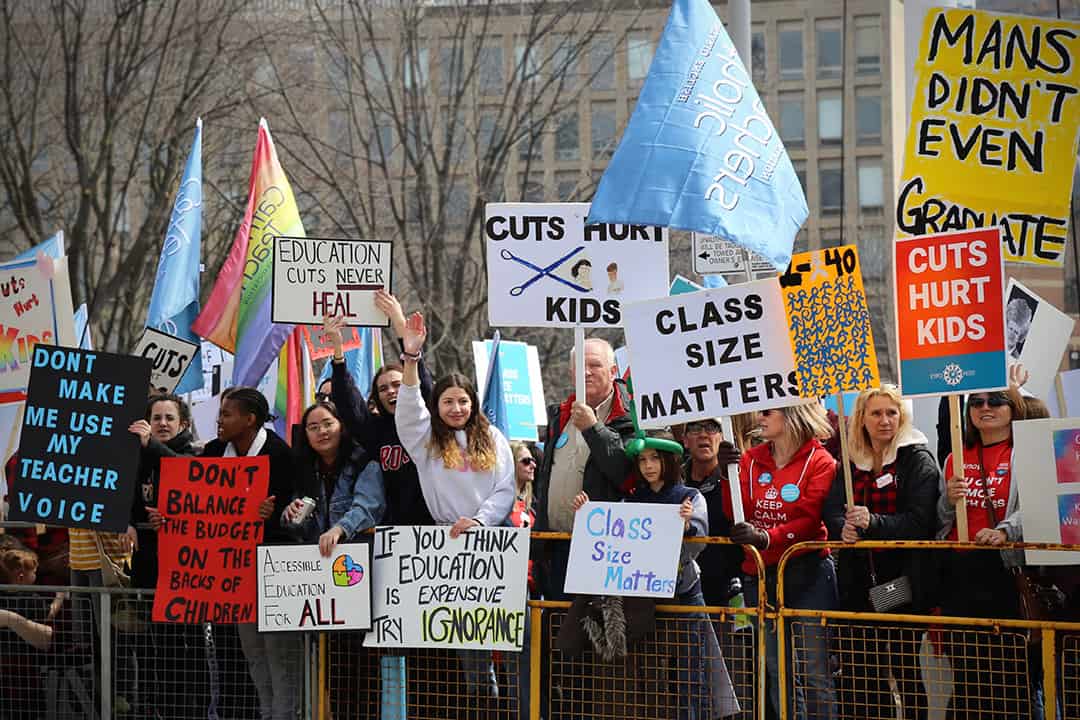On April 6, thousands of people crowded the lawns of Queen’s Park. Union flags swung above the crowd while kids dodged through protesters’ legs, dragging cardboard signs behind them.
Jointly organized by five Ontario teachers’ unions, the Rally for Education was held to protest the Ford government’s proposed cuts to education funding. Teachers, students, and concerned citizens shook signs and fists at the Ontario Legislative Building, which loomed over those gathered in its shadow.
Under the government’s new plan, 3,475 full-time teaching positions would disappear, with 1,558 positions this coming school year alone. Doug Ford further plans to increase the average class sizes of both elementary and high schools, as well as introduce mandatory online classes for secondary students. The government also proposed sweeping changes to funding for students with autism, which would drastically reduce their overall support.
Teachers, already underpaid and overworked, are infuriated. But not out of concern for their jobs or their workloads. Overwhelmingly, they’re worried about their students and what these cuts will mean for their quality of education.
To get a better sense of what this means, I asked two Ottawa-based middle school teachers: Lori-Ann Zylstra and Cindy May, who’ve both worked in education for over two decades.
Cindy is my mom, and Lori-Ann is her sister, my aunt. They’re both represented by the Ontario English Catholic Teachers’ Association and teach in rural schools outside of Ottawa. They woke up at 4:30 am to catch the bus to Toronto for the rally and went back that same afternoon.

Lori-Ann, Cindy, and the author
“I went to the protest today because I felt it was really important to stand and be counted,” Lori-Ann told me. “I think there’s a lot of misunderstanding among the general public simply because they’re not teachers. When people hear 28 kids as a class size, for example, they don’t realize that that’s an average.”
Cindy nodded. “I have huge concerns about the impact of the cuts on the classroom. And what it’s actually going to mean, face to face, day to day with the students,” she added.
Classes are already dangerously large, they explained, and increasing them further will have significant negative effects on students. On rare occasions when a number of students are not in class, Cindy told me, “students who are remaining will almost always say, ‘Wow, this is so nice, we have so much time to talk about things and do things.’”
They’re also concerned about the impact the funding cuts will have on students with autism. “Doug Ford presents it like some new thing that there will be students with autism in the classroom,” Lori-Ann said, but “it is already common for me to have one or more students who are on the autism spectrum in my class.”
She’s received no special training in how to better teach children with unique needs, but there is usually extra funding to provide specialized support. But “what [Ford] is going to do is take it all away and fund them with the same amount as a kid who isn’t on the spectrum,” she explained. This will transfer sole responsibility of their care to already-overburdened teachers.
While Lori-Ann told me that she wouldn’t mind taking on those responsibilities, she explained that “the problem is that it is already challenging to adequately service the the academic and social and emotional needs in my classroom.”
“The government claims… cuts are about fiscal responsibility,” Cindy continued. “If this is what all these changes and cuts are supposed to be about, then let’s get to the real meaning of that. Let’s address the mental health needs of our students, the social determinants of their health, development needs and so on. What are we doing now to address those?” She shook her head.
Both Cindy and Lori-Ann were also deeply concerned about what mandatory online courses for high school students might mean. “Unless you are a student who is very self-directed with lots of initiative, you aren’t going to succeed in online-only courses,” Lori-Ann explained. Furthermore, “the strong possibility is that there’s going to be private companies administering these courses,” which would effectively “move us toward the two-tier educational system,” she said.
A two-tier educational system would look something like this: children from wealthy families would be sent to high quality private schools, whereas children from poorer families would be effectively ghettoized into lower quality public schools. “And I think this is just Doug Ford’s first step into privatizing education. He’s trying to Americanize it.” Lori-Ann warned. “And we see where that’s gotten the Americans,” Cindy added.
If this worries you, take action. Cindy and Lori-Ann both hoped everyday people would engage critically with the government’s rhetoric and “just ask teachers questions, ask [them] what [they’re] so upset about.” Members of the public are also welcome to join teachers in the #RedForEd campaign, wherein supporters wear red shirts every Friday in solidarity with teachers and education workers. But most importantly, show up! “Anytime that there’s any sort of rally or protest, everyone is welcome,” Lori-Ann smiled.
“This was just the first step, I’m certain, in a series of movements and initiatives that teachers are going to take,” she said.
“In my 25 years of teaching, I’ve never seen anything like [these cuts],” Cindy said. “We have a fight on our hands. And as teachers we need to be prepared to step up and fight for our students education.” We all do.


